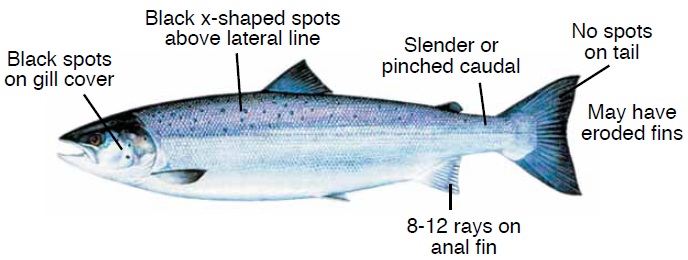Identify your catch
Pacific salmon and trout
Pacific salmon
Chinook salmon

Chum salmon

Coho salmon

Pink salmon

Sockeye salmon

Features of Pacific salmon
| Species | Mouth | Tail | Other distinguishing features | Age at maturity | Freshwater markings |
|---|---|---|---|---|---|
| Chinook | Dark with black gums; large, sharp teeth | V-shaped, silvery; spots on both lobes | Large spots on back | 3 to 7 years | Body turns olive brown to black |
| Chum | White, tongue may be black; large teeth | No spots, silver streaks covering about half of tail; narrow tail base | No spots on back or tail; possible faint vertical bars on silver fish; white tip on anal fin | 3 to 5 years | Vertical bands on sides, may be reddish purple on male |
| Coho | White, may have black edge, white gums; sharp, medium sized teeth | Square, silver; some spots, usually on upper lobe; wide tail base | Spots on upper part of body | 3 years | Greenish black head, red body |
| Pink salmon | White with black gums; in marine areas, almost no teeth | V-shaped, no silver; large oval spots on both lobes | Large spots on back; smallest species | 2 years | Pronounced hump on male |
| Sockeye salmon | White with white gum line; small teeth | Moderately forked; no spots | No spots on back or tail; prominent, glassy eyes | 4 to 5 years | Greenish head, red body |
Atlantic salmon
Report all captures of Atlantic salmon to: 1-800-811-6010 (toll-free).
Click thumbnail to enlarge image.
Trout
| Species | Identifying features |
|---|---|
 Trout - Cutthroat |
|
 Trout - Steelhead (Oncorhynchus mykiss) |
|
 Trout - Dolly Varden |
|
Groundfish
| Species name | Identifying features |
|---|---|
 Lingcod (Ophiodon elongatus) |
|
 Pacific Cod (Gadus macrocephalus) |
|
 Sablefish (Anoplopoma fimbria) |
|
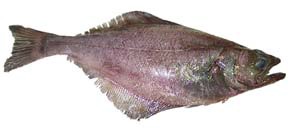 Arrowtooth Flounder (Atheresthes stomias) |
|
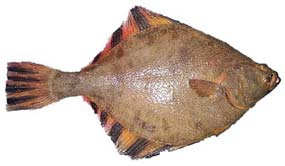 Starry Flounder (Platichthys stellatus) |
|
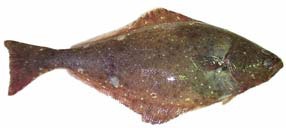 Pacific Halibut (Hippoglossus stenolepis) |
|
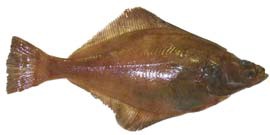 English Sole (Parophrys vetulus) |
|
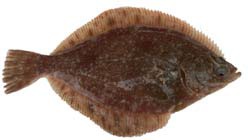 Rock Sole (Lepidopsetta bilineata) |
|
 Pacific Sanddab (Citharichthys sordidus) |
|
 Big Skate (Raja binoculata) |
|
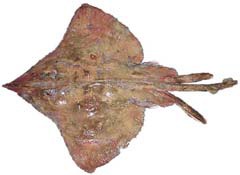 Longnose Skate (Raja rhina) |
|
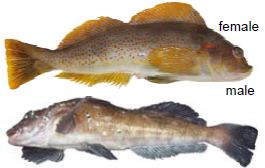 Kelp Greenling (Hexagrammos decagrammus) |
|
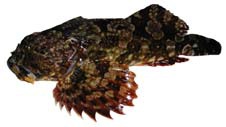 Cabezon (Scorpaenichthys marmoratus) |
|
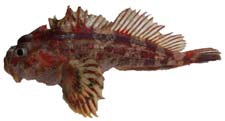 Red Irish Lord (Hemilepidotus hemilepidotus) |
|
 Ratfish (Hydrolagus colliei) |
|
 Spiny Dogfish (Squalus acanthias) |
|
Rockfish
- Inshore benthic species
- Mostly found in shallow depths but range from 0-300 fathoms (0-600 metres)
- Adults live close to the bottom usually in rocky areas with high relief bottoms
- Some species like to hide in rocky crevices
- Midwater species
- Mostly found in intermediate depths but range from 0-300 fathoms (0-600 metres)
- Adults live near the bottom
- More likely to be schooling fish
- Most numerous near the edge of the continental shelf
- Deep benthic species
- Mostly found in deeper depths but range from 50-1000 fathoms (100-2000 metres)
- Most species are red in colour
- Mixture of on-bottom, near-bottom and off-bottom schooling species
- Most abundant in the upper regions of the continental shelf slope
| Species name | Identifying features | Species location |
|---|---|---|
 Deacon Rockfish (Sebastes diaconus) |
|
Midwater species |
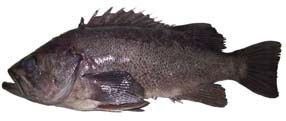 Black Rockfish (Sebastes melanops) |
|
Midwater species |
 Brown Rockfish (Sebastes auriculatus) |
|
Inshore benthic species |
 China Rockfish (Sebastes nebulosus) |
|
Inshore benthic species |
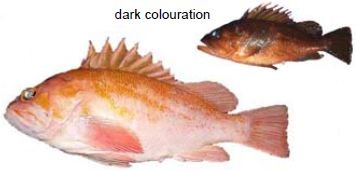 Copper Rockfish (Sebastes caurinus) |
|
Inshore benthic species |
 Quillback Rockfish (Sebastes maliger) |
|
Inshore benthic species |
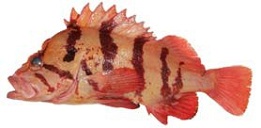 Tiger Rockfish (Sebastes nigrocinctus) |
|
Inshore benthic species |
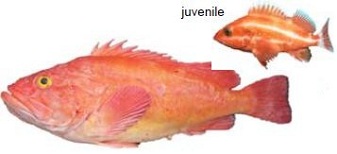 Yelloweye Rockfish (Sebastes ruberrimus) |
|
Deep benthic species |
 Bank Rockfish (Sebastes rufus) |
|
Midwater species |
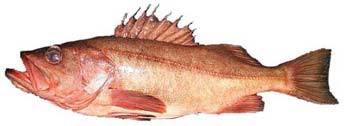 Bocaccio (Sebastes paucispinis) |
|
Midwater species |
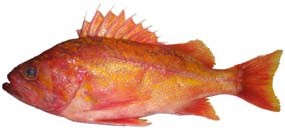 Canary Rockfish (Sebastes pinnigers) |
|
Deep benthic species |
 Chilipepper (Sebastes goodei) |
|
Midwater species |
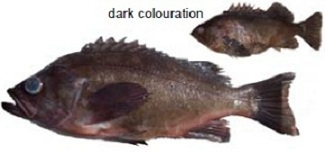 Dusky Rockfish (Sebastes ciliatus) |
|
Midwater species |
 Greenstriped Rockfish (Sebastes elongatus) |
|
Midwater species |
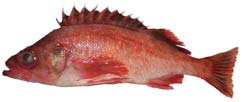 Harlequin Rockfish (Sebastes variegatus) |
|
Midwater species |
 Northern Rockfish (Sebastes polyspinis) |
|
Midwater species |
 Puget Sound Rockfish (Sebastes emphaeus) |
|
Midwater species |
 Pygmy Rockfish (Sebastes wilsoni) |
|
Midwater species |
 Shortbelly Rockfish (Sebastes jordani) |
|
Midwater species |
 Silvergray Rockfish (Sebastes brevispinis) |
|
Midwater species |
 Stripetail Rockfish (Sebastes saxicola) |
|
Midwater species |
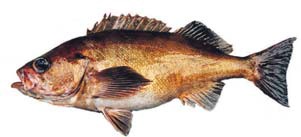 Widow Rockfish (Sebastes saxicola) |
|
Midwater species |
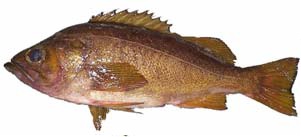 Yellowtail Rockfish (Sebastes flavidus) |
|
Midwater species |
 Aurora (Sebastes aurora) |
|
Deep benthic species |
 Blackgill Rockfish (Sebastes melanostomus) |
|
Deep benthic species |
 Darkblotched Rockfish (Sebastes crameri) |
|
Deep benthic species |
 Longspine Thornyhead Rockfish (Sebastolobus altivelis) |
|
Deep benthic species |
 Pacific Ocean Perch (Sebastes alutus) |
|
Deep benthic species |
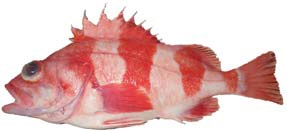 Redbanded Rockfish (Sebastes babcocki) |
|
Deep benthic species |
 Redstripe Rockfish (Sebastes proriger) |
|
Deep benthic species |
 Rosethorn Rockfish (Sebastes helvomaculatus) |
|
Deep benthic species |
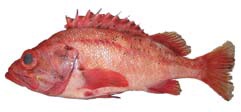 Rougheye Rockfish / Blackspotted complex (Sebastes aleutianus) |
|
Deep benthic species |
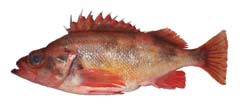 Sharpchin Rockfish (Sebastes zacentrus) |
|
Deep benthic species |
 Shortraker Rockfish (Sebastes borealis) |
|
Deep benthic species |
 Shortspine Rockfish (Sebastolobus alascanusi) |
|
Deep benthic species |
 Splitnose Rockfish (Sebastes diploproa) |
|
Deep benthic species |
 Vermillion Rockfish (Sebastes miniatus) |
|
Deep benthic species |
 Yellowmouth Rockfish (Sebastes reedi) |
|
Deep benthic species |
Keep an eye out for this species of Special Concern!
Rougheye / Blackspotted Complex is often misidentified as a Shortraker Rockfish which looks similar. Living up to 140 years of age, this SARA-listed species of Special Concern is possibly the longest lived fish species on earth and it needs your protection.
Total length: Up to 80 centimetres — that’s almost 3 feet!
Unique features: 2 –10 spines below the eyes and long thin gill rakers on the first gill arch
Color spectrum underwater: Pink, tan or brownish; may have brown or bronze blotches or saddles
Color spectrum above the surface: Pink or bright red with black or grey blotches.
Protect this significant species— always record and report unintended catch.
Saltwater finfish
| Species name | Identifying features |
|---|---|
 Lingcod (Ophiodon elongatus) |
|
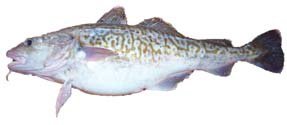 Pacific Cod (Gadus macrocephalus) |
|
 Pacific Halibut (Hippoglossus stenolepis) |
|
 English Sole (Parophrys vetulus) |
|
 Pacific Sanddab (Citharichthys sordidus) |
|
 Kelp Greenling (Hexagrammos decagrammus) |
|
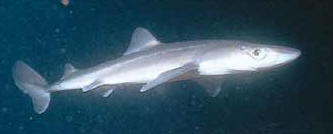 Spiny Dogfish (Squalus acanthias) |
|
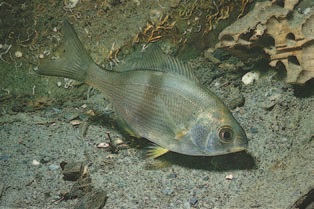 Surfperch (Embiotocidae) |
|
 Herring (Clupea) |
|
 Pacific Sardine (Sardinops sagax) |
|
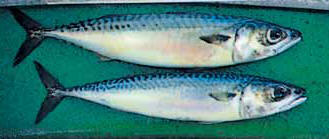 Mackerel (Scombridae) |
|
 Smelt (Osmeridae) |
|
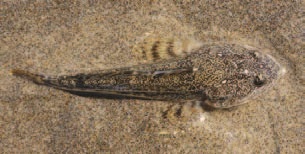 Sculpin (Cottoidea) |
|
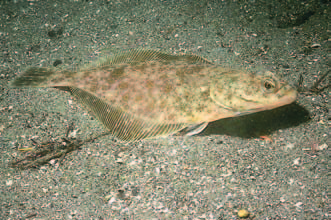 Sole/Flounder (Soleidae) |
|
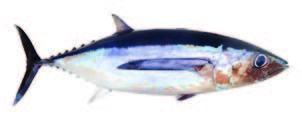 Tuna (Thunnas) |
|
 Sablefish (Anoplopoma fimbria) |
|
 Ratfish (Hydrolagus colliei) |
|
 Big Skate (Raja binoculata) |
|
 Northern Anchovy (Engraulis mordax) |
|
 Trout - Cutthroat |
|
 Trout - Steelhead (Oncorhynchus mykiss) |
|
 Trout - Dolly Varden |
|
Sturgeon

- Mainly bottom dweller, found inshore and in large river systems
- Maximum length/weight: 6 m, 600 kg
- Long nose, projecting mouth, whiskers near tip of snout. Armour-like plates instead of scales
- Catch and release fishing only
Sturgeon are a cartilaginous, almost prehistoric-looking fish that can grow to six metres long and weigh over 600 kg.
Their elongate body usually ranges from greenish grey on the back to light grey or white on the belly. Instead of scales, their bodies have five rows of large armour-like plates know as scutes. They have long noses and projecting mouths, located on the lower part of the head, accompanied by four fleshy whiskers known as barbels.
There are two species of sturgeon in B.C., the white sturgeon and the green sturgeon. Both occur along the coast in inshore waters and in medium to larger river systems. When observed, green sturgeon, the rarer and smaller of the species, are usually encountered further offshore.
Related links
Shellfish
Shellfish include all aquatic invertebrates: clams, cockles, crabs, mussels, oysters, prawns, scallops, sea urchins, and shrimp. Octopus, sea cucumbers and squid are also managed as shellfish in British Columbia.
Butter, littleneck, manila and varnish clams can be found in gravel and sand beaches in protected bays.
Razor clams live on wave-swept sand beaches open to the Pacific Ocean.
| Species name | Identifying features |
|---|---|
Butter clam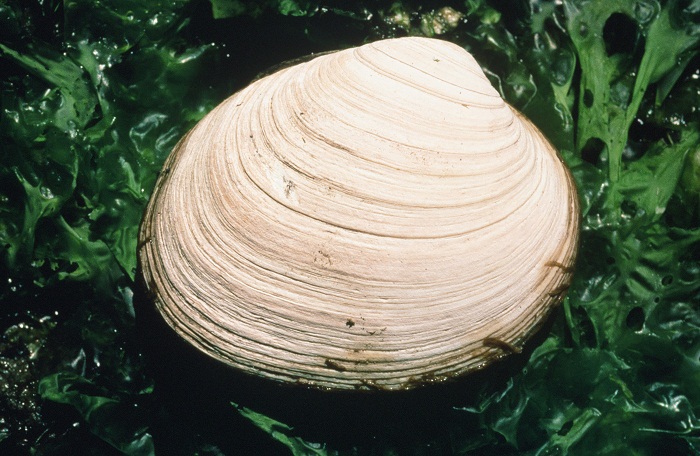
Butter clam |
|
Geoduck clam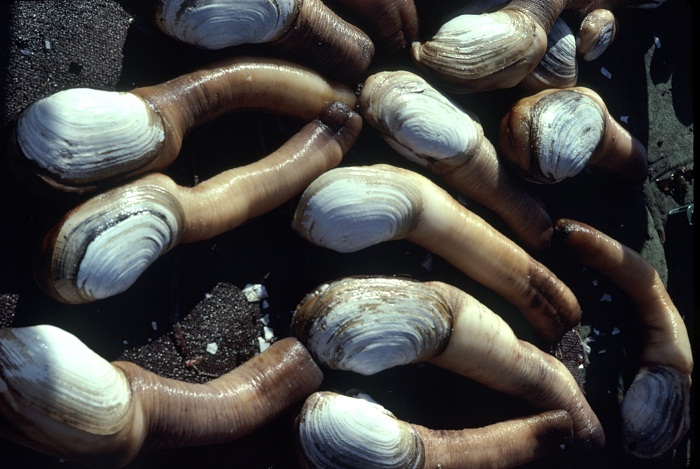
Geoduck clam |
|
Littleneck clam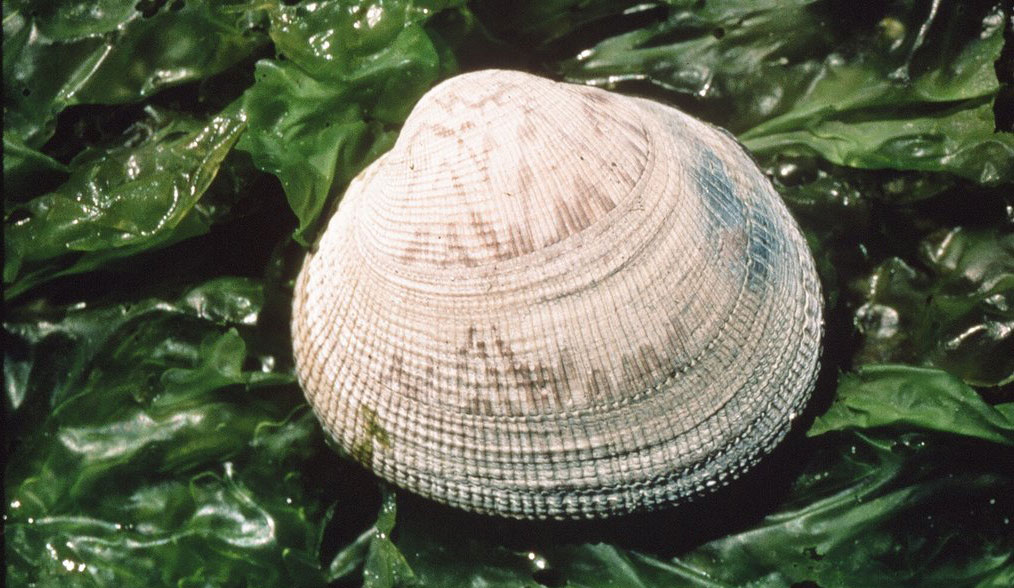
Littleneck clam |
|
Manila clam
Manila clam |
|
Varnish clam
Varnish clam |
|
Razor clam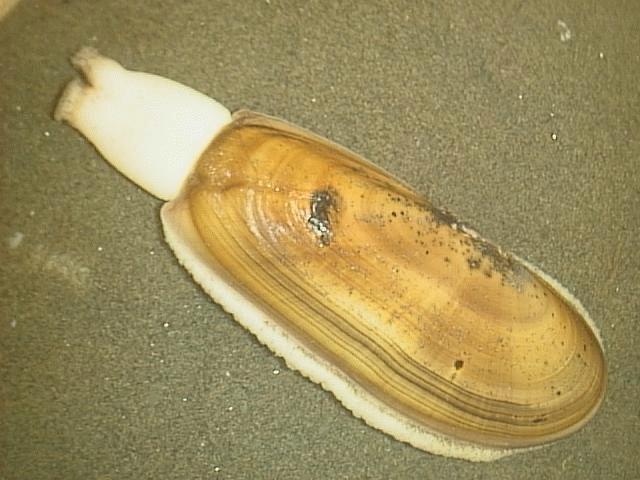
Razor clam |
|
Blue mussel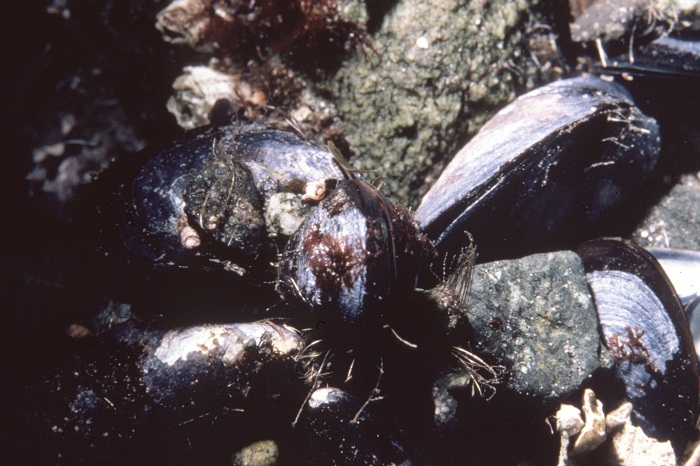
Blue mussel |
|
Pacific Oyster
Pacific Oyster |
|
Olympia oyster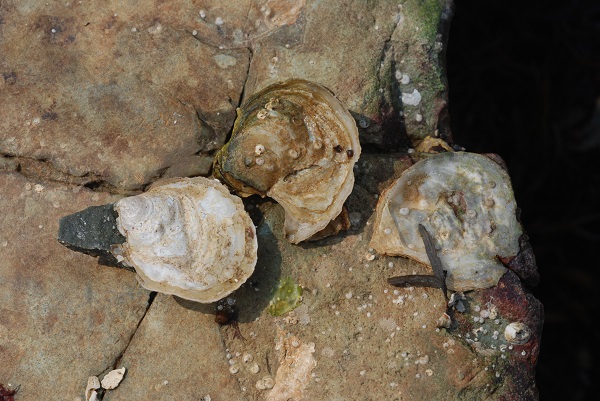
Olympia oyster |
|
Abalone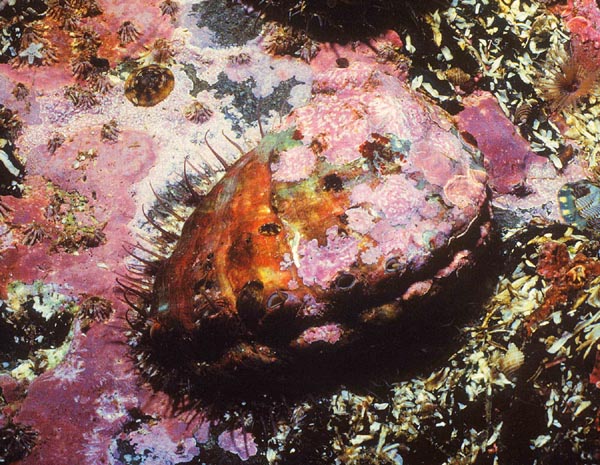
Abalone |
Northern abalone is listed as endangered under Canada’s Species at Risk Act. It is illegal to fish for abalone, to harm or harass them or to possess any abalone or part of abalone, including the shell. |
Shrimp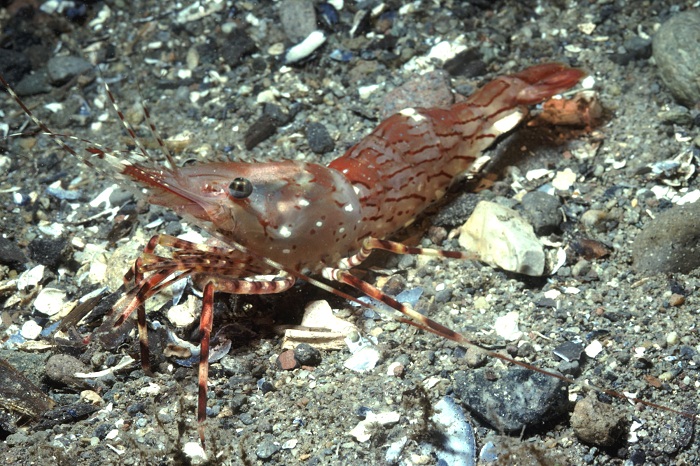
Shrimp |
|
Prawn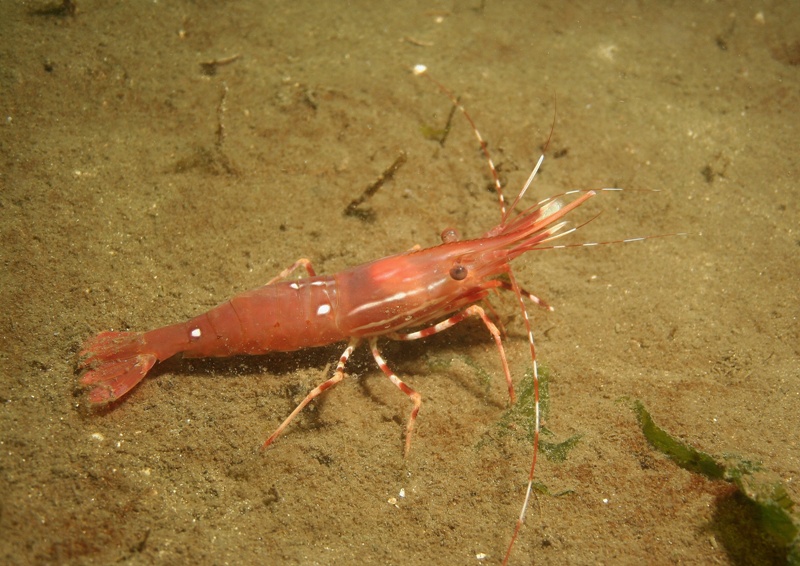
Prawn |
|
Squid
Squid |
|
Crab
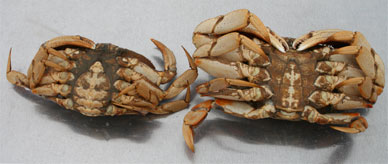
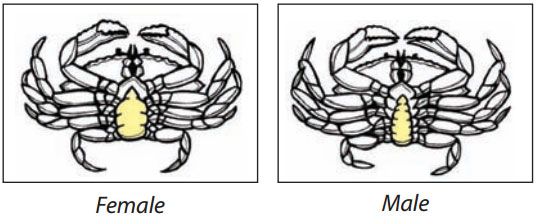
How to identify a crab
- 3 to 4 pairs of walking legs
- 1 pair of claws for feeding and defence
- Female carries egg clusters on underside of body
Crab sex is determined by looking at the abdomen shape
- Female’s abdomen has a wide “beehive” shape
- Male’s abdomen has a narrow “lighthouse” shape
It is illegal to possess female Dungeness or red rock crabs.
| Species | Characteristics |
|---|---|
Dungeness crab
Dungeness crab |
|
Redrock crab
Redrock crab |
|
European green crab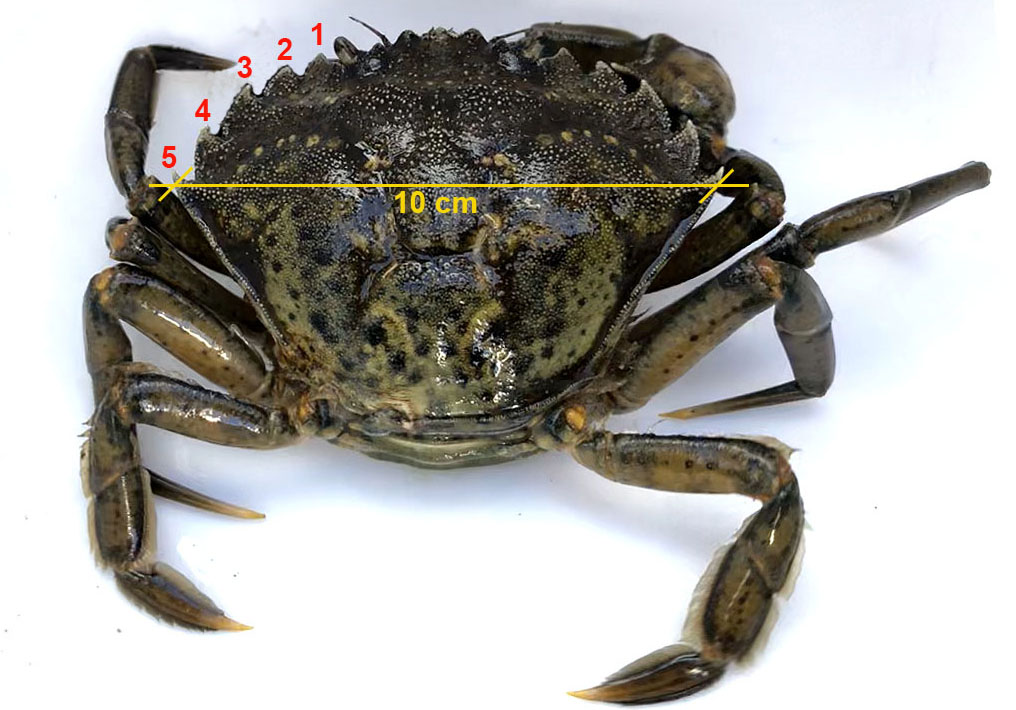
European green crab |
European green crab is an invasive species. |
- Date modified:
